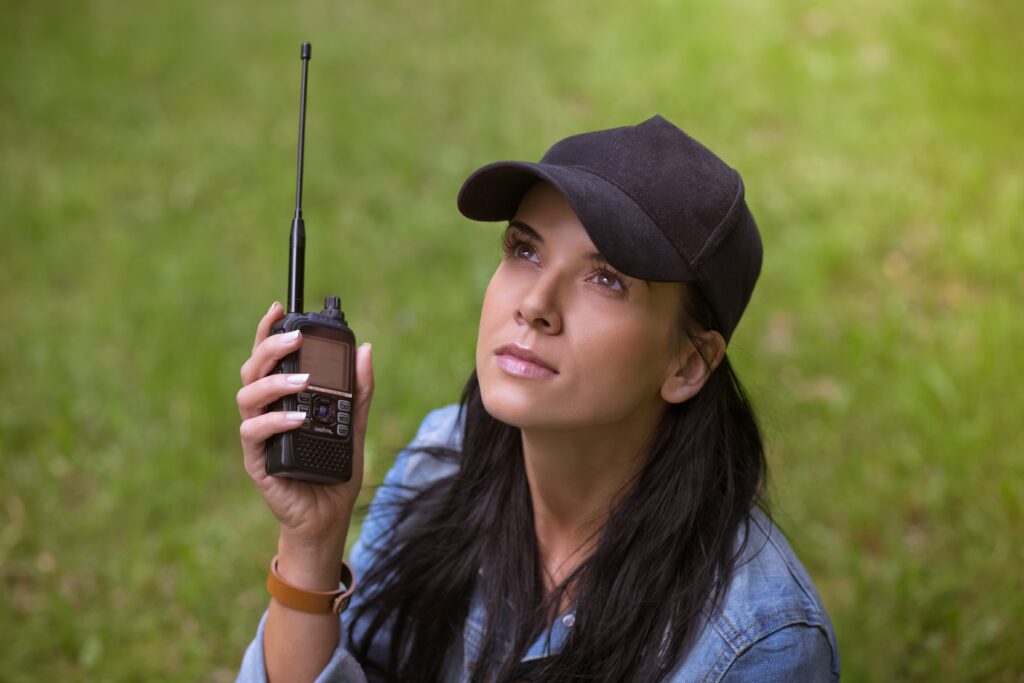By Andy Valencia
Last issue, I talked about the strength of ham radio in providing communications during catastrophic disruptions of our traditional networks. But what does a ham radio operator do when the world hasn’t gone full Mad Max?
If you have a handie-talkie (a hand-held radio, about the size of a cell phone), the most basic activity is to tune in a local repeater, make sure you’re not interrupting anybody, and transmit your call sign and “monitoring”. You might hear me say “K6AJV monitoring”. K6AJV is my legal identifier, and saying you’re “monitoring” means you’re open to a conversation.
Somebody might well call you back – but what do you talk about?
Anything. Because you’re both hams, there’s a built-in conversational starting point. Where are you, what equipment are you using, what kind of antenna? Does it work well? Do you have hopes for something newer and better? Are you a new ham? When did you first get licensed, and what was your first “rig”– that is, radio?
It doesn’t have to be about radio. If you mention that your radio is mounted in a classic Camaro, your fellow ham might come back to tell you about his restored Model T in the garage. Who knows? It could just as well be about the weather and your weather-monitoring station. Or they might be just visiting, and you can warn them about some road work to avoid.
Sometimes a group of hams gets on the radio at the same time on a daily or weekly basis. For years, there was a “road runner net” in the Seattle area, a group of hams who talked with each other as they commuted. It was natural to be talking about vacations, new vehicles, or their promotion at work. Usually, at least one ham would share the dumb joke of the day.
Your handie-talkie or car-mounted radio uses frequencies that reach across a city or county. When you get home, perhaps after dinner, you can turn on your shortwave radio, connected to an antenna mounted on your roof. Because of the sun’s effect on the ionosphere, during the day you’ll be able to use shortwave frequencies to reach across the nation, and often out to other countries. At night, it’s more typical to reach people in your state and a couple of adjacent ones.
As an oddity of history, on shortwave instead of saying “K6AJV monitoring”, you instead call “CQ CQ CQ this is K6AJV K6AJV K6AJV”. The conversational possibilities when somebody calls you back are similar to what you’d experience on your handie-talkie. The wrinkle is, the person you talk with can be multiple states over, or even multiple nations. Radio models and antenna designs are common the world over – but if you both have a child in college, the details described by a ham in Italy can differ from your own experiences in fascinating ways. The same with food, vacations, or even how they do house-wiring.
My previous article talked about “repeaters,” a ham counterpart to a cell tower. Hams form clubs, and very often one club activity is to put up a repeater and maintain it. That’s just the starting point, since a club is inevitably a social organization. Potlucks, white elephant parties, as well as technical presentations are all typical at a monthly meeting.
In addition to local clubs, hams have a central organization that represents them, the Amateur Radio Relay League, “ARRL.” One of the ARRL’s functions is to administer awards, permitting a ham to have official recognition of notable achievements. The “Worked All States” award is given when a ham submits proof of contacts with at least one ham in each of our 50 states. “Worked All Continents” is similar for talking to at least one ham on each continent. DXCC is the “DX Century Club”, a prestigious award for having talked with hams in 100 different countries. Hams usually frame this certificate and hang it on the wall above their shortwave station. The ARRL also administers contests. One of interest to Vashon is the annual “Islands on the Air,” where hams across the world try to talk to as many hams on as many different islands as possible. Vashon-based hams suddenly become very popular!
The most famous contest is “field day,” where hams pack up their radio and batteries to go somewhere off the grid. They then see how many other off-grid hams they can reach. Often, the antenna is just a wire looped over the highest tree branch they can reach at their campground.
Hams have put up satellites known as OSCAR – Orbital Satellite Carrying Amateur Radio – which can be reached from any ham on the ground as the satellite passes overhead. When an astronaut on the International Space Station is a ham operator, there’s a station up there and they can “work” hams down on earth during their off-hours.
And then there’s the truly exotic. EME – Earth Moon Earth – also known as “moonbounce.” Hams with huge antennas and high-power transmitters can beam a signal at the moon and reach amateurs across half of the earth as the signal bounces off the moon and then strikes the earth just shy of three seconds after it left the transmitter.
There’s digital modes of communication, like email and texting, and there’s techniques for communicating across vast distances using tiny amounts of transmit power. In the latter, advanced digital signal processing teases the message out from the background noise where the human ear can detect nothing.
Traditionally known as a “fox hunt,” there is a game where you try to find a hidden transmitter using a directional antenna; no animals are ever harmed! There’s also an entire sub-genre of hams who build their own radio equipment by hand. There are still hams who communicate using the “dits” and “dahs” of Morse code. Whatever your interests, there’s probably a part of the hobby that would interest you.
Get started at arrl.org or w7vmi.org

